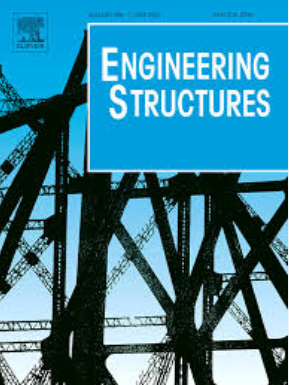Prediction of monitoring data and state assessment of heritage stone-timber structures based on spatio-temporal graph neural networks
IF 5.6
1区 工程技术
Q1 ENGINEERING, CIVIL
引用次数: 0
Abstract
This study aims to improve the accuracy of monitoring data prediction and structural state assessment for preserving cultural heritage stone-timber structures. Significant spatial correlation and temporal dependence are revealed in the monitoring data. A novel spatio-temporal graph neural network (GLSTNN) is therefore proposed to predict monitoring data and assess the structural state of heritage building. The GLSTNN combines Graph Attention Networks and Long Short-Term Memory Networks to model the spatio-temporal characteristics of monitoring data. This study constructs irregular topological graphs based on physical proximity and data similarity to represent the spatial relationships between sensors. Additionally, residual connections are introduced in GLSTNN to enhance the model’s ability to represent non-linear data. To validate the proposed approach, a case study is conducted on a heritage stone-timber structure located in Tibet, China, where sensors monitor structural strain, tilt angles, and environmental temperature and humidity. Data from 18 monitored parameters are used for validation. Experimental results show that incorporating temperature and humidity effects improves predictive performance by strengthening the spatio-temporal relationships among sensors and better capturing environmental impacts. The GLSTNN model outperforms existing techniques in structural state prediction and anomaly detection, providing accurate identification of anomalies and prediction of key parameters from the measured data. The proposed approach has a high potential to offer a promising solution for complex heritage stone-timber structures.
基于时空图神经网络的遗产石木结构监测数据预测与状态评估
本研究旨在提高文物石木结构保护监测数据预测和结构状态评估的准确性。监测数据具有显著的空间相关性和时间依赖性。为此,提出了一种新的时空图神经网络(GLSTNN)来预测监测数据和评估文物建筑的结构状态。GLSTNN结合了图注意网络和长短期记忆网络来模拟监测数据的时空特征。本研究基于物理接近度和数据相似度构建不规则拓扑图来表示传感器之间的空间关系。此外,在GLSTNN中引入残差连接,增强了模型表示非线性数据的能力。为了验证所提出的方法,我们对位于中国西藏的一处遗产石木结构进行了案例研究,在那里传感器监测结构应变、倾斜角度和环境温度和湿度。来自18个监测参数的数据用于验证。实验结果表明,温度和湿度效应通过加强传感器之间的时空关系,更好地捕捉环境影响,提高了预测性能。GLSTNN模型在结构状态预测和异常检测方面优于现有技术,可以准确识别异常并从测量数据中预测关键参数。提出的方法具有很高的潜力,为复杂的遗产石木结构提供了一个有前途的解决方案。
本文章由计算机程序翻译,如有差异,请以英文原文为准。
求助全文
约1分钟内获得全文
求助全文
来源期刊

Engineering Structures
工程技术-工程:土木
CiteScore
10.20
自引率
14.50%
发文量
1385
审稿时长
67 days
期刊介绍:
Engineering Structures provides a forum for a broad blend of scientific and technical papers to reflect the evolving needs of the structural engineering and structural mechanics communities. Particularly welcome are contributions dealing with applications of structural engineering and mechanics principles in all areas of technology. The journal aspires to a broad and integrated coverage of the effects of dynamic loadings and of the modelling techniques whereby the structural response to these loadings may be computed.
The scope of Engineering Structures encompasses, but is not restricted to, the following areas: infrastructure engineering; earthquake engineering; structure-fluid-soil interaction; wind engineering; fire engineering; blast engineering; structural reliability/stability; life assessment/integrity; structural health monitoring; multi-hazard engineering; structural dynamics; optimization; expert systems; experimental modelling; performance-based design; multiscale analysis; value engineering.
Topics of interest include: tall buildings; innovative structures; environmentally responsive structures; bridges; stadiums; commercial and public buildings; transmission towers; television and telecommunication masts; foldable structures; cooling towers; plates and shells; suspension structures; protective structures; smart structures; nuclear reactors; dams; pressure vessels; pipelines; tunnels.
Engineering Structures also publishes review articles, short communications and discussions, book reviews, and a diary on international events related to any aspect of structural engineering.
 求助内容:
求助内容: 应助结果提醒方式:
应助结果提醒方式:


